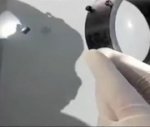Solar power has proven itself to be a viable and clean energy option, but it usually requires some sort of conversion mechanism and equipment to be put to use.
For example, in a grid connect solar power system, solar panels convert light from the sun into DC electricity, which is then run through a power inverter that converts it to AC electricity, suitable for use by home appliances.
Researchers at the University of California, Berkeley, are utilizing carbon nanotubes to build small machines directly propelled by solar power. They believe the technology could be scaled up to make energy generating pumps directly powered by the sun.
In lab experiments, when light is focused on one of these machine floating on a pool of water, the nanotubes warm and heat the water around them. This creates decrease in water surface tension localized to one area of the machine, which is in turn propelled forward away from the low-tension part of the surface.
Another machine consists of a simple rotor with a nanotube strip on one side of each of its four fins. When exposed to direct sunlight, it spins at about 70 rotations per minute.
The carbon nanotubes are the blackest materials ever tested, absorbing almost all the light that falls on them.
The researchers are aiming to create real boats. Lenses mounted on the back of a large boat in theory should focus sufficient sunlight on the carbon nanotubes to propel it. They also hope to make large nanotube-embedded rotors for solar powered generators.
Read more about harnessing direct solar power for propulsion












































